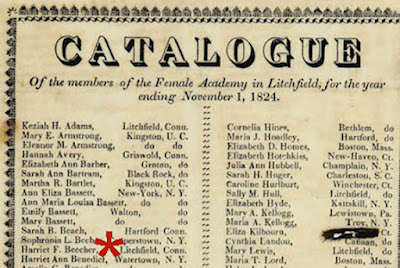Detail of a cut-out chintz applique quilt in the collection of the
Metropolitan Museum of Art in New York.
Tree of Life quilt
110" x 92"
When donor Elsey R. Taft gave the quilt to the museum in 1970 she attributed it to an ancestor (we presume) Mary Malvina Cook Taft (1812-1905.) Mary lived in Sag Harbor, on eastern Long Island, New York for much of her life. When she and her husband Horatio Nelson Taft first married they lived in western New York on the Erie Canal where her 4 children were born.
The caption for the quilt indicates the curators had little information about Mary Cook Taft.
"According to family history, Mary Malvina Cook Taft made the quilt for her trousseau. She probably made it about 1835, since she was born in 1812 and probably married in her twenties, as was common at the time."
Julia Taft Bayne (1844-1933) in 1928
I just happened to be looking for more information about Mary Malvina Cook Taft when I stumbled upon this quilt attributed to her hand. Mary's life is well documented in the published writings of her daughter Julia Taft Bayne and in her husband Horatio Taft's diary in the collection of the Library of Congress.
1905 Obituary, Brooklyn Eagle
Mary was born in 1812 and died almost 100 years later. She married
in 1843. She's buried in Sag Harbor, where she lived most of her life.
Bridgehampton, her birthplace, is close by.
People in the neighborhood of the Hamptons did not make quilts that looked like this, style the Met curators have noted:
"There is no documentation of where the piece was made, but stylistically it seems most closely related to documented bedcovers from Maryland, Virginia, and South Carolina."
International Quilt Museum Collection
The cut-out chintz applique style was, as they note, a Southern specialty. The quilt above
is dated 1837 and signed Susan Pritchard Kirkwood of Charleston, South Carolina.
MESDA Collection, attributed to Margaret Wynens Alexander of North Carolina
The Museum of Early Southern Decorative Arts (MESDA) owns many Southern bedcovers in similar style. See this search:
Several of the MESDA quilts make use of the popular palm tree and pheasant
chintz that is in the Metropolitan's Quilt.
Swainson's Pheasant & Palm Tree
Thousands of yards of this bird print must have been
imported from England. There were also knock-offs.
The chintz quilt is definitely not New York style and there is little chance that Mary Taft made it. How did a Southern quilt wind up in a New York family? Two possibilities: Mary's only daughter Julia Taft Bayne lived in Florida in her later years after living in the midwest where her husband was a minister. Could she have found this quilt in Florida and handed it down to a family member?
Julia Taft Bayne about the time she lived
in Washington
An even more intriguing idea is that Mary Taft herself spent about 4 or 5 years in the South---in Washington D.C., a Southern town despite the fact that it was the capitol of the Union during the Civil War, which is when Mary lived there. Horatio, suffering from economic problems after the Panic of 1857, accepted a government position in the Patent Office from President James Buchanan's administration. The family lived a few blocks from the White House until the spring of 1862 when they returned to New York.
Halsey Taft & Horatio Taft Jr.
The Tafts fell in with the new President's family after Mary Todd Lincoln invited Mary Taft's two sons to play with her own boys Tad and Willie. Might Mary Taft have acquired a Southern quilt during the Civil War, a war trophy carried to the Capitol by a Union soldier?
I first read about Mary Malvina Cook Taft in her daughter's charming book Tad Lincoln's Father, published in 1931. Mary remains a bit of a mystery since daughter Julia didn't seem fond of her company. Her husband mentioned Mary in his daily journal but one never gets a glimpse of her personality except that she was quite conventional, worried about appearances and was a pious Presbyterian. And she did not care for Washington.
Julia also syndicated magazine articles about the Washington
years in the 1920s & early '30s.
Each year we do a pieced Block of the Month here, and the 2024 pattern series will be Washington Whirlwind, based on Julia's book about the White House boys. Still working on the stories and the patterns for next January.
Tad Lincoln's Father is still in print, published
by University of Nebraska press.
A preview:






















.jpg)







































